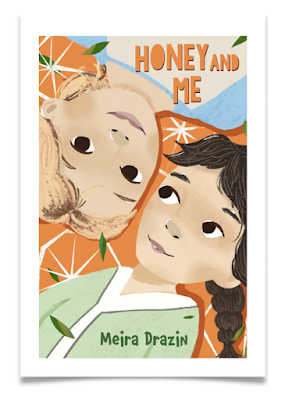REPRESENTATION Purim
Meira Drazin’s debut middle-grade Honey and Me was published in 2022 by Scholastic Press. It had already attracted much pre-publishing attention because of its representation. In 2023, Honey and Me was honoured by the Sydney Taylor Book Award, which recognises “outstanding books for children and teens that authentically portray the Jewish experience.” It has two star reviews from Kirkus and School Library Journal and was a Kirkus Best Middle Grade Books of 2022 selection. Adding another bell to her whistle, the book was just recognised by the Children’s Book Council’s 2023 Notable Social Studies Trade Books Award Winners.
This year the Jewish holiday of Purim begins on 6th March at sundown and lasts through sundown on 7th March. I am guessing that unlike the High Holidays in the fall (Rosh Hashanah—the Jewish New Year, and Yom Kippur—the Day of Atonement) and Passover in the spring, which are major Jewish holidays that people might have heard of; or Chanukah which is a minor Jewish holiday but because of its proximity to Christmas has taken on more mainstream prominence— Purim is not a festival most people would have heard of or know much about.
But if anyone has ever heard the expression “the whole Megillah,” meaning ‘a whole long story,’ the Book of Esther (known in Hebrew as ‘Megillat Esther’ because it’s written on a scroll—megillah), in which the story of Purim is told and is read twice on the holiday— is where this expression originates.
The Intercession of Esther with King Ahasuerus and Haman by Pietro Paolini c. 1625 (source)
Indeed, like Milla, I have never dressed up in costume for Halloween or gone trick or treating. (From reading A Place at the Table by Laura Shovan and Saadia Faruqi, I learned that for the same reason—its pagan idolatry roots—many Muslim children do not either, and I felt a thrill at discovering this connection. Windows and mirrors, guys!) When I first started writing stories for children, though, the psychological impact of not seeing myself reflected back in literature became apparent. I copied the way other authors wrote: I sent my characters to regular schools, not a Jewish day school; I had them dress up for Halloween, not Purim. Basically, I believed the world I knew best wasn’t legitimate enough to write about.
I didn’t set out to be the first author to write a contemporary realistic coming-of-age middle-grade novel set in a Modern Orthodox community—and I have been surprised that this has become one of Honey and Me’s calling cards. But I did want to write a book about Modern Orthodox characters who have close friendships, difficult mother-daughter relationships, and influential teachers. I wanted them to encounter situations that are funny as well as sad. I wanted to write a book that I would have loved to read as a child. Mostly, I just really wanted to write a book about observant Jews whose experience of their Judaism is on the balance joyful, and not in conflict with anything. And whereas my earlier efforts at writing for children were missing something, giving myself permission finally to imagine characters in a world that was familiar to me and with the religious rhythms that organise my own family’s life, gave me the chance to create characters who feel like people you might know, regardless if you are someone who comes from the same kind of community or someone who simply knows these characters because they feel familiar in your heart and emotions.
The thematic events of Purim have repeated themselves many times through ancient and more recent history, on large and small scales, and without the benefit of a heroine or hero who saves the day at the last minute. Unfortunately, antisemitism is a reality. My children’s Jewish schools in London have significant security at their gates. At times we have been instructed for the children to fold their blazers—whose school crest includes Jewish symbols— into their knapsacks until they are inside school so that they do not present a target. But thankfully this is not the majority of mine or my community’s life right now. Mostly what we do is live our lives, our religion both integral and yet incidental.
So, without wanting to sound too lofty, my hope is that Honey and Me can also offer an antidote to othering—the foundation of any racism, even when casual and unintentional—by bringing vividly to life characters whose religious practices may be foreign to many readers, but whose hearts, struggles, and humanity are the same.
Happy Purim!
*
Meira Drazin was in the lowest reading group in first grade, although once she finally learned to read she never stopped and will read almost anything (unless it’s way too scary) in almost any genre. Originally from Toronto, Canada, she lived in New York City for many years, and now lives in London, England with her husband and four children. She studied literature at Barnard College and has an MA in English and Comparative Literature from Columbia University. Find Meira here.
*
Eva Wong Nava is a children’s book author interested in world festivals. She is a child of the Chinese diaspora and she celebrates the Lunar New Year, the Mid-Autumn Festival as well as the Dragonboat Festival, which are ancient Chinese festivals still celebrated by over 2 billion people of the Chinese diaspora world-wide. Her recent picture book I Love Chinese New Year was published by Scholastic UK just in time to celebrate the Year of the Rabbit in 2023. You can find her here or email her w&prepresents@britishscbwi.org















No comments:
We love comments and really appreciate the time it takes to leave one.
Interesting and pithy reactions to a post are brilliant but we also LOVE it when people just say they've read and enjoyed.
We've made it easy to comment by losing the 'are you human?' test, which means we get a lot of spam. Fortunately, Blogger recognises these, so most, if not all, anonymous comments are deleted without reading.